NOT RECOMMENDED
What an amazing theater town Los Angeles is, each month offering literally hundreds of shows to pick from—big budget/big bucks/big stage productions at the Pasadena Playhouse or the Geffen, midsized offerings like those at the Colony and ICT Long Beach, and 99-seat plan productions at Theatre @ Boston Court, Antaeus, and the Celebration—to name just three of the many small theaters which easily match the best of off-Broadway. Add to these the countless 30, 40, and 50-seat mini-theaters where it’s possible to “put on a show” for about .005% of Broadway’s Spider Man budget, and you’ve got oodles of temptations on any given weekend.
The Big Woogie, now playing at North Hollywood’s 46-seat Raven Playhouse, fits smack-dab into the final category. It represents its playwright/co-director Ray Ramos’ and co-director Stan Matasavage’s first stage effort. Most of its cast members are new to this reviewer. It has clearly been put together with a whole lot of love and enthusiasm—and one heck of a poster design.
In fact, the show’s sensational poster so accurately imitates those of 1940s/50s film noir classics like Nightmare Alley, The Asphalt Jungle, and Criss Cross that The Big Woogie may end up disappointing audiences expecting its advertised “Four Noir Acts Of Thrills And Chills.” Only one of its four playlets has a 1940s setting, and one of them is pure screwball with only a hint of noir. (Those two, which bookend intermission, also happen to be the production’s best.)
Act One (Forgive Me Charlton, I Have Sinned) has its femme fatale fortune teller Maya (Cassie Maloney), her carnival clown lover Lon (Gordon Alatorre), and Lon’s dwarf partner (Joseph Childs) sweating in the sweltering Nevada desert circa 1977, and is filled with numerous ‘70s (and Charlton Heston) references. Anyone expecting a happy ending for all three hasn’t seen his or her share of film noir.
Act Two (Room 509) is Hollywood screwball with a classic 1920s setting (the Ambassador Hotel), a movie star leading lady (Amanda Jones as real-life legend Louise Brooks), references to a pair of famous Howards (Hawks and Hughes), and an 11th hour appearance by one of them (incorrectly named in the program). There’s also Louise’s hysterical sidekick Myron (David Lengel) and a Mexican-Irish house detective named Chico Flynn (Matthew Dorio) who’s gotten a phone tip that they’ve killed one of the aforementioned H.H.’s. Understudy Vinnie van Hinte pops in late in the tale to add to the mayhem.
Act Three (A Touch Of Murder) recalls the classic Sorry Wrong Number in its tale of a bedridden invalid (Candice Martin as Candice Pierce) who, following the departure of kindly caretaker Mrs. Gillespie (Mindee de Lacey), finds herself alone on a dark and stormy night with only a live Orson Welles radio broadcast to keep her company. When Orson (voiced by Ramos) starts describing Candice’s life and actions to a T, the woman in question gets to worrying that she might just end up scared to death, that is if the intruder Welles informs her of doesn’t get her first.
Finally, the Tarantinoesque Act Four (The Big Woogie) takes us to present-day Las Vegas and features a woman called Her (Dina-Nicki Rassias), a German called The Guy (Peter McGlynn), and a henchman called Roger (Max Schneider)—all of them after something called “The Big Woogie.” A fourth character, Byron, was understudied by Ramos at the performance reviewed.
I thoroughly enjoyed the screwball antics of Room 509, with the delightfully perky Jones (as a kooky Louise Brooks quite different from her public persona), a comedically brilliant Lengel, and a spot-on Dorio, the trio providing laughs galore on the way to runway-ready van Hinte’s last minute arrival with a bootprint covering half of his handsome face.
A terrific Martin’s very real terror in A Touch Of Murder combined with Welles’s Big Brother awareness of her every move make for an all-too-short blend of screams and laughs, marred only by a sloppily executed lighting cue, one requiring the director to begin the applause, the audience having no idea the act was over, and forcing Martin to exit in full view.
Acts One and Four pleased me less, the former’s sleazy tone and the latter’s quirkiness not particularly matching my tastes, despite committed work by both casts.
Set designer Yuki Nakamura has managed quite effectively to create four different rooms on a limited budget, however scene changes require cast members to work overtime as stagehands, moving walls, tables, chairs, and assorted props in preparation for each following act. A detective-garbed Ramos interacts with audience members standup-style during these overlong interludes, a conceit which works ony the first time or two. If there was partial nudity, as promised in the program, I missed it.
Jon Archibald’s moody lighting, Alisa Steen’s varied costumes, and Bill Froggatt’s sound design are all quite good. Alatorre, Martin, Matasavage, and Ramos are producers and Milton Alex Chi is stage manager.
Though not the success it sets out to be, The Big Woogie has clearly been created with a lot of love and dedication as indicated by the post-performance enthusiasm exhibited outside the theater by cast and crew and the friends who’d come to cheer them on.
The Raven Playhouse, 5233 Lankershim Blvd., North Hollywood.
http://fla.vor.us/bigwoogieproductions
–Steven Stanley
August 14, 2011

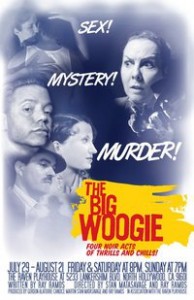
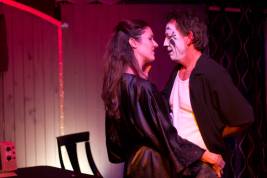
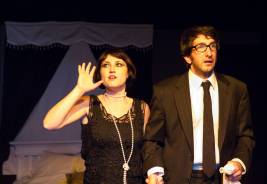
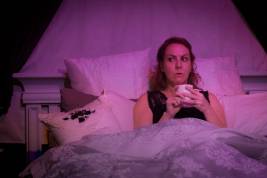
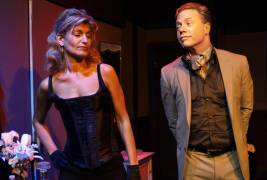

 Since 2007, Steven Stanley's StageSceneLA.com has spotlighted the best in Southern California theater via reviews, interviews, and its annual StageSceneLA Scenies.
Since 2007, Steven Stanley's StageSceneLA.com has spotlighted the best in Southern California theater via reviews, interviews, and its annual StageSceneLA Scenies.







 COPYRIGHT 2025 STEVEN STANLEY :: DESIGN BY
COPYRIGHT 2025 STEVEN STANLEY :: DESIGN BY